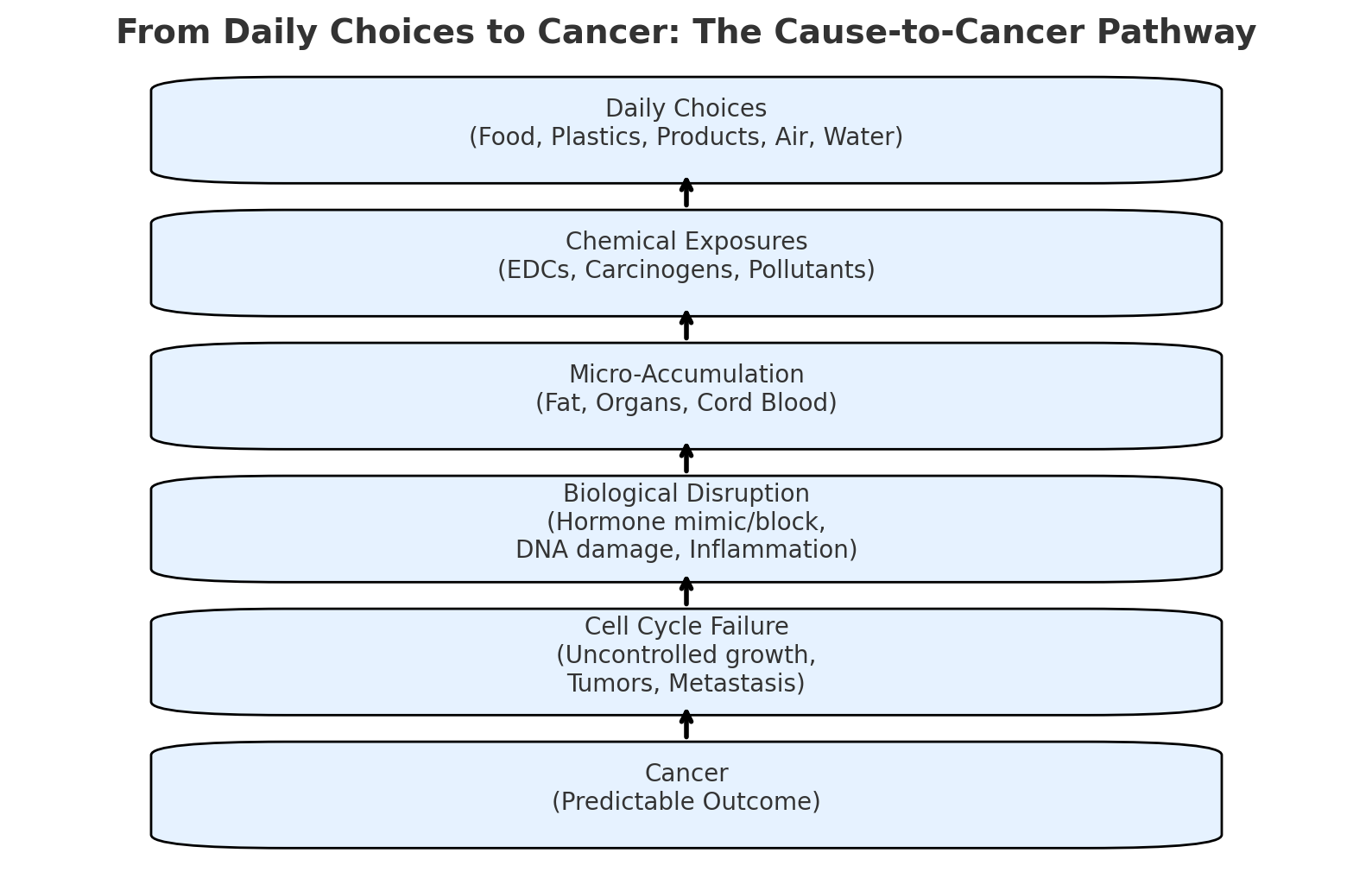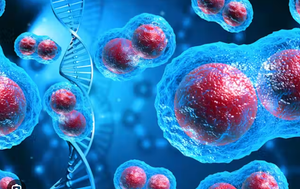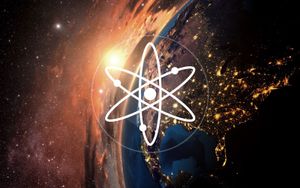Cancer is not a random curse. It is the predictable result of choices made over the last 100 years. Every product on a shelf, every dollar exchanged, and every business model designed without conscience has shaped the environment inside our bodies.
What Cancer Is
- Cancer = uncontrolled cell growth.
- Normal cells divide, repair, and die when signaled.
- Cancer cells ignore stop signals. They keep dividing, form tumors, and may spread.
How Cells Go Rogue
- DNA Damage
- Carcinogens (cancer-causing agents) damage DNA or alter how genes switch on and off.
- Over time, mutations build up. A “normal” cell loses control of growth.
- Hormone Disruption
- Endocrine-disrupting chemicals (EDCs) mimic or block hormones.
- They overstimulate growth pathways (estrogen, androgens, thyroid).
- Hormone-sensitive tissues (breast, prostate, thyroid, testes) become prone to cancer.
- Chronic Inflammation
- Processed food, tobacco, alcohol, and pollution create constant low-grade inflammation.
- Inflammation produces free radicals that damage DNA and cell machinery.
- Epigenetic Changes
- Even without changing DNA, chemicals and poor lifestyle alter gene expression.
- This silences protective genes and activates growth-promoting ones.

The Sources in Daily Life
Plastics
- BPA and phthalates leach from bottles, cans, packaging. Mimic estrogen.
Food - Pesticide residues, additives, processed meats. Linked to colorectal and breast cancer.
Household Products - Flame retardants in furniture. Parabens and triclosan in cosmetics. Disrupt hormones.
Air & Water - Diesel exhaust, PFAS (“forever chemicals”), heavy metals in drinking water.
Workplaces - Solvents, asbestos, industrial byproducts.
Lifestyle - Smoking, alcohol, high-sugar diets, inactivity. They multiply risk when combined with chemical exposures.
The Process of Micro-Accumulation
- Small exposures add up daily.
- Fat-soluble chemicals (like dioxins, PCBs, PFAS) lodge in fat tissue and organs.
- They stay for decades, slowly released back into blood.
- Babies inherit this load — cord blood studies show hundreds of chemicals present before birth.
The Outcome
- 1 in 2 people will develop cancer in their lifetime.
- 70% of disease burden is preventable through reducing exposures and changing daily habits.
- Cancer is not random. It is the outcome of cumulative exposures and lifestyle patterns we created.
Plain Truth for Everyone
Every purchase is a choice.
- Plastic bottle or glass?
- Fast food or fresh whole food?
- Chemical-laden cleaner or natural alternative?
- Dollars spent on sickness industries or prevention and regeneration?
We caused this reality, consciously and unconsciously. Which means we also hold the power to uncreate it.
The Proof We Cannot Ignore
- 1933: Journalists warned in 100,000,000 Guinea Pigs that people were being used as test subjects for untested chemicals.
- 1962: Rachel Carson’s Silent Spring revealed pesticides were poisoning ecosystems and people.
- 2005: The Environmental Working Group found 287 industrial chemicals in the cord blood of newborns — including 180 known carcinogens.
- 2009: The Endocrine Society confirmed that endocrine-disrupting chemicals interfere with hormones and increase risk of infertility, obesity, diabetes, thyroid disease, and hormone-sensitive cancers.
The evidence is clear. We are born pre-polluted. Cancer risk is built into the very products and systems we call “progress.”
How We Created It
- Every purchase of plastic bottles, processed food, or cheap cosmetics feeds industries that saturate daily life with endocrine disruptors.
- Every unconscious business that ignores environmental cost externalizes disease onto future generations.
- Every dollar spent on convenience fuels a feedback loop: toxins in our soil, water, food, air, and bodies.
Governments normalize harm. Fast fake food is legal. Pesticides and industrial chemicals are tolerated at “acceptable levels.” Clean organic food is luxury. Natural medicine is marginalized. The system profits more from illness than wellness.
The Result
- 1 in 2 people will face cancer in their lifetime.
- 7 in 10 live with at least one chronic disease.
- Global sperm counts have dropped by more than 50% in 50 years.
- Children are born carrying industrial legacies in their blood.
This is not fate. This is architecture. We built it with our hands, our wallets, and our silence.
The Fork in the Road
We are the cause. We can also be the cure.
- Demand transparency.
- Refuse toxic products. "toxic free life"
- Build businesses that regenerate, not extract.
- Spend every dollar as if it votes for the world your children will inherit.
The Truth
Cancer is not only in our genes. It is in our choices.
We created this epidemic. Now we must uncreate it.
100 Year Plan - 2025 - 2125
Principles to reverse the last 100 years.
- Humility. Admit harm. Publish where products, policies, and practices caused exposure and disease.
- Accountability. Measure exposures in people and places. Report openly. Set targets. Tie leadership pay to progress.
- Responsibility. Polluter pays. Fund cleanup, prevention, and care in the communities harmed first.
Phase 1. Years 1 to 10
- Set national and city targets to cut top endocrine disruptors in people and water. Public dashboards. Quarterly updates.
- Ban high risk chemicals in food contact, infant products, schools, and hospitals.
- Full ingredient disclosure for all products. No trade secret shields for chemicals.
- Launch biomonitoring for pregnant people, infants, and workers. Offer exposure reduction support.
- Upgrade drinking water systems to remove PFAS and other persistent chemicals. Independent lab audits.
- Replace thermal paper receipts with non bisphenol options. Move to e receipts by default.
- Remove PVC and phthalates from medical devices. Shift to safer plastics and silicone.
- Require safer substitution in factories. Use green chemistry checklists before any new molecule enters market.
- Shift procurement. Governments, hospitals, and schools buy EDC free products only.
- Tax toxic inputs. Lower taxes and offer credits for safer materials and clean processes.
- Build a national cleanup fund for legacy sites. Prioritize schools, day care, and low income areas.
- Healthcare integrates environmental exposure screening. Brief advice at every visit. Provide simple how to guides.
- Education adds hormone health and environmental literacy to K to 12 and trade schools.
- Corporate reports include chemical footprints, water discharges, and product level disclosures.
Phase 2. Years 10 to 25
- Replace pesticides with integrated pest management and agroecology. Track pesticide load in foods.
- Redesign packaging to glass, stainless, paper, or certified safe polymers. Eliminate fluorinated coatings.
- Retrofit wastewater plants. Capture industrial discharges at source.
- Set indoor air standards for schools and workplaces. Remove flame retardants that are not needed for safety.
- Expand product take back and extended producer responsibility. Close the loop with safe materials only.
- Fund research on low dose and mixture effects. Publish all results in open access databases.
- Build chemical transparency into digital product passports. Scan and verify on purchase.
Phase 3. Years 25 to 50
- Achieve large reductions in population levels of BPA, phthalate metabolites, PFAS, and flame retardants. Update targets every five years.
- Restore rivers, wetlands, and soils that store and filter pollution. Track contaminant declines with public maps.
- Harmonize global rules on testing before market. No sale without full safety data across life stages.
- Make all new buildings EDC free by standard. Furniture, insulation, wiring, sealants, and finishes meet a clean list.
Phase 4. Years 50 to 75
- Complete cleanup of legacy hot spots. Long term monitoring remains in place.
- Lock in precautionary decision rules. If hazard flags, pause or pull the product until proven safe across windows of vulnerability.
- Align health funding with prevention. Pay for outcomes that lower exposures and disease, not volume of treatment.
- Secure health equity. The highest risk communities see the fastest exposure decline.
Phase 5. Years 75 to 100
- Keep the loop tight. All materials safe by design. Full traceability from source to reuse.
- Maintain public right to know. Live dashboards, independent audits, and community oversight.
- Teach each generation the link between hormones, environment, and health. Keep skills current in science, trades, and policy.
What you do today
- Drink filtered water certified for PFAS and other target chemicals. Change filters on time.
- Store and heat food in glass or stainless. Do not heat plastic.
- Buy fragrance free personal care. Read ingredient lists. Choose short lists you understand.
- Choose whole foods. Wash produce. Support organic and agroecology when you have access.
- Ventilate your home daily. Vacuum with a HEPA filter. Wet dust surfaces.
- Avoid thermal paper receipts. Take e receipts.
- Reduce canned foods with epoxy linings. Choose glass jars or fresh options.
- Check product certifications for safer chemistry. Prefer third party labels with full criteria.
- Share this plan with your family and workplace. Make a short checklist. Start with three changes.
What your business does this year
- Map your chemical footprint. List inputs, products, emissions, and waste.
- Remove bisphenols, phthalates, PFAS, and unnecessary flame retardants from all products and packaging.
- Install capture and treatment at discharge points. Publish test results.
- Train staff in safer substitution and purchasing. Set supplier rules and deadlines.
- Create a public improvement plan with dates, budgets, and metrics. Report progress quarterly.
What your city or country does this year
- Pass right to know laws for product ingredients and emissions.
- Fund biomonitoring and cleanup in high risk areas. Offer exposure reduction services.
- Set drinking water limits for PFAS and other priority chemicals. Enforce with independent checks.
- Align food policy with prevention. Support farmers to reduce pesticide load. Improve school meals.
- Add environmental health to primary care. Pay for brief counseling and community programs.
How we track progress
- Annual report on human biomonitoring for priority chemicals across age groups.
- Annual report on chemicals in water, soil, house dust, and indoor air.
- Public targets for exposure reduction and disease trends. Independent verification.
- A registry of safer alternatives with performance data, costs, and case studies.
- A grievance and remedy process for communities. Clear steps and timelines.
Humility in action
- Acknowledge past harm. Name the products, policies, and decisions that caused it.
- Compensate affected people and places. Fund care, cleanup, and jobs in restoration.
- Invite independent scientists, workers, and frontline communities into decision rooms.
- Learn from Indigenous knowledge holders about stewardship and long view thinking.
Your next step
Pick one personal action, one workplace action, and one civic action from above. Do them this week. Share your results with one person. Repeat next week with three more. This is how we uncreate what we created. Together, with honesty and care.
References
- Endocrine Society Scientific Statement on Endocrine-Disrupting Chemicals (2009, 2015)
Landmark global reviews linking EDCs to reproductive disorders, cancers, obesity, diabetes, and thyroid disease.
👉 https://www.endocrine.org/topics/edc - Environmental Working Group (2005) — Cord Blood Study
Found 287 industrial chemicals in newborn cord blood, including carcinogens and neurotoxins.
👉 https://www.ewg.org/research/body-burden-pollution-newborns - World Health Organization (WHO) — Cancer Fact Sheet
Confirms that at least 30–50% of cancers are preventable through lifestyle and environmental changes.
👉 https://www.who.int/news-room/fact-sheets/detail/cancer - International Agency for Research on Cancer (IARC, WHO arm)
Monographs identifying carcinogens in the environment, workplace, and consumer products.
👉 https://monographs.iarc.who.int/ - National Cancer Institute (NCI) — Carcinogens and Cancer Risk
Explains how chemicals, radiation, and lifestyle factors trigger uncontrolled cell growth.
👉 https://www.cancer.gov/about-cancer/causes-prevention/risk/substances - Our World in Data — Cancer and Chronic Disease Burden
Data on global cancer incidence, trends, and preventable causes.
👉 https://ourworldindata.org/cancer - Silent Spring by Rachel Carson (1962)
Classic book exposing dangers of pesticides like DDT, laying groundwork for modern environmental health science.
👉 https://www.rachelcarson.org/SilentSpring.aspx - Cochrane Reviews on Lifestyle and Cancer Prevention
Systematic reviews showing links between smoking, alcohol, processed foods, and cancer risk.
👉 https://www.cochranelibrary.com/




